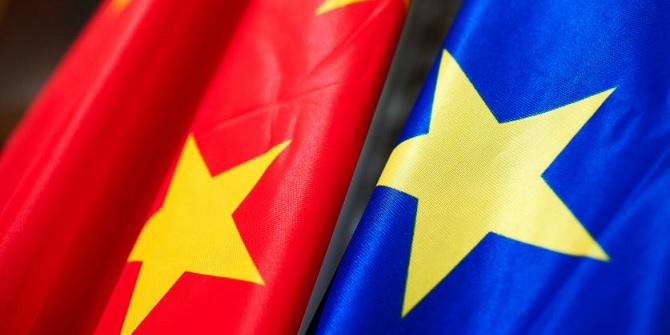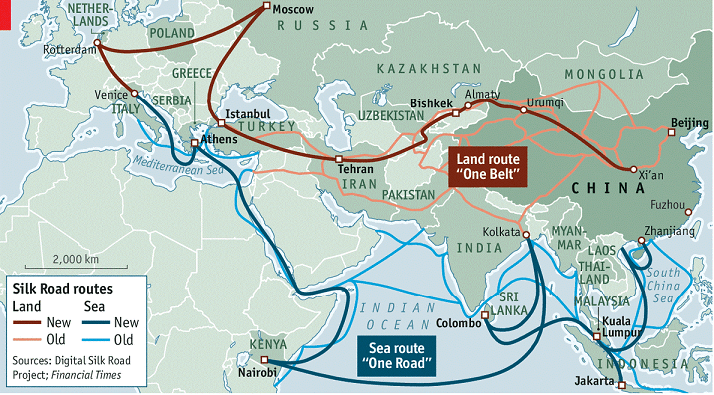An EU alternate to OBOR?
May 8, 2018 | Expert Insights

The European Union has created a preliminary draft for a Europe-Asia Connectivity plan, which some have compared to China’s Belt and Road initiative. The Belt and Road initiative is a central feature of Chinese foreign policy. It underlines China’s goal to assume a larger role in international affairs, with Beijing as the centre of a global trade network.
Background
China’s One Belt One Road Initiative (OBOR) was announced in 2013. Hailed as a “21st Century Silk Road”, the initiative seeks to revive trade routes across Eurasia. OBOR has been publicised as a development strategy that involves huge amounts of physical infrastructure, including railroads, highways, ports, and pipelines. China also claims that it will enhance financial linkages and increase cooperation across the landmass. According to the World Bank, OBOR has the potential to include “65 countries, 4.4 billion people, and about 40% of the global GDP”.
The proposed economic corridor is divided into the land-based Silk Road Economic Belt (SREB) and the 21st Century Maritime Silk Road (MSR). The land route is intended to stretch from central China through Central Asia and Russia, into Western Europe. The oceanic “road” includes ports and littoral infrastructure across South and South East Asia, the Gulf, and ends in East Africa and the Mediterranean. The European route would link China (14% of world GDP) to the EU (21% of world GDP).
India is one of the few South Asian countries that has not signed the deal. India remains highly sceptical of increasing Chinese influence in its neighbourhood. One of India’s main issues with OBOR is the China Pakistan Economic Corridor (CPEC). CPEC not only gives China access to the Gwadar port in the Arabian Sea, but also runs partly through Pakistan occupied Kashmir. China has not yet addressed India’s concerns on this issue.

Analysis
China’s keystone project has received substantial criticism. India, Japan, and the US have expressed concerns over OBOR. In February 2018, Britain expressed doubts about whether or not it would meet global standards. A source from the German foreign ministry told media that the initiative would have to be in line with labour and environment standards. Most recently, a US defence official accused Beijing of “predatory economic activities” in the Indian Ocean region, due to its investments in the Hambantota port in Sri Lanka and Gwadar in Pakistan.
In April 2018, it was revealed by a German newspaper that a number of EU ambassadors to China had signed a report criticizing the Belt and Road Initiative. The report accused China of trying to shape globalization to suit its own personal interests. However, China denied the validity of this report. Read more on this report here.
The Centre for Global Development, a Washington based think tank, published a paper noting that China’s “Belt and Road Initiative” creates the potential for debt-sustainability problems. Researchers stated that it puts Djibouti, Kyrgyzstan, Laos, the Maldives, Mongolia, Montenegro, Pakistan and Tajikistan “at particular risk of debt distress”.
In February, the European Commission released a document on a “Europe-Asia Connectivity plan”, which is expected to be presented at the 12th Asia-Europe (ASEM) Summit in Brussels. The document stresses on connectivity, including “all modes of transport links (land, sea and air) as well as digital and energy links in the Euro-Asian area.” European construction and trade associations have praised the idea of an alternate connectivity plan.
Frans-Paul van der Putten, a researcher from the Netherlands Institute of International Relations said, “The EU is unhappy that many countries in Asia and Eastern Europe seem to regard China as the main source of investment in greater regional integration, whereas in the view of the EU it is itself a much larger actor in this regard.” India, Japan, Australia, and the United States have also reportedly been in talks to establish their own global framework, called the “Quadrilateral Security Dialogue” or the “Quad”.
Counterpoint
There has been no unified EU policy towards OBOR yet. Some EU countries, including Austria, Spain, and Netherlands, have welcomed Chinese investments. Fourteen EU countries are members of the China-led Asia Infrastructure Investment Bank (AIIB). Proponents of OBOR have noted that different global initiatives could work in tandem with the Belt and Road Initiative. Bernt Berger from the German Council on Foreign Relations said that OBOR could be a point of collaboration. “Most people in Berlin think the belt and road is a good idea… Many German companies are already involved in belt and road projects,” he said.
China has argued in favour of this initiative, noting that this could potentially revive and boost the economies of multiple countries across the world including Pakistan. It has responded to criticisms that OBOR lacks transparency by emphasising that there are “no back-room deals” when it comes to OBOR.
Assessment
Our assessment is that countries may be growing increasingly wary of debt traps and dependency on China and may be pre-emptively diversifying their trade networks. A major challenge for OBOR in Europe could be to adapt to EU standards of labour and environment. However, as stated previously ,we believe that some of the more powerful nations in Europe could see OBOR as a threat to their own power and influence in the world. This could pose a threat to Beijing’s ambitious project.
Read more: China defends OBOR








Comments